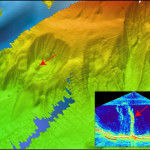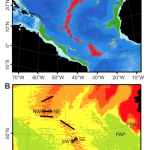
Editor’s Note: The following interview was conducted by Colin Schultz for American Geophysical Union’s (AGU) member publication Eos. AGU and Colin have been kind enough to let Deep Sea News reprint the interview for our readers! Peter Rona is a legend in hydrothermal vent research.
Colin Schultz, Diversity of Hydrothermal Systems on Slow Spreading Ocean Ridges, Eos 92 (8), 68-69, February 22, 2011. Copyright 2011 American Geophysical Union. Reproduced/modified by permission of American Geophysical Union.
————————————————-
In the past 3 decades, hydrothermal vents on the deep seafloor have captivated our imagination. The otherworldly vistas of vent ecosystems with chemosynthetic bacteria, animals new to science, billowing black smokers, and brightly colored polymetallic sulphide mineral deposits have changed our perception of the ocean’s depths. In the new AGU monograph Diversity of Hydrothermal Systems on Slow Spreading Ocean Ridges, editors Peter A. Rona, Colin W. Devey, Jérôme Dyment, and Bramley J. Murton and participating authors take readers to the exciting exploration frontier of seafloor hydrothermal research on the slow spreading half of the 55,000-kilometer-long ocean ridge that spans the Atlantic, Indian, and Arctic oceans. In this interview, Eos talks with Peter Rona.
Eos: This monograph is part of a series focusing on ocean ridges and hydrothermal vents. Why are these systems so important?
Rona: Ocean ridges are where two thirds of the Earth’s lithosphere is generated and most hydrothermal activity occurs, so ridges are immensely important in terms of Earth processes. The study of hydrothermal vents at ocean ridges was launched in earnest in the 1970s when it was shown that they are quantitatively significant in exchanging heat and chemicals between the Earth’s interior and the oceans. Earth is a water-cooled planet, and hydrothermal systems at ocean ridges account for at least one third of the cooling. Additionally, the elements and compounds that are discharging from these systems are the basis for a whole ecosystem based on chemical energy, which is a counterpart to photosynthesis on land, with implications for the origin of life.
Eos: What is the history of hydrothermal vent exploration? What was your role in this research?
Rona: The first high-temperature vents discharging at temperatures of hundreds of degrees Celsius found on an ocean ridge were discovered in 1979 on the East Pacific Rise, spreading at an intermediate full rate (6 centimeters per year) near the mouth of the Gulf of California. The consensus of the scientific community at that time was that high-temperature vents could only occur at intermediate to fast spreading ridges, which are present only in the Pacific. So investments in exploration were concentrated in the Pacific. The community considered the slow spreading ridges in the Atlantic, Indian, and Arctic oceans off limits for exploration for high-temperature hydrothermal systems.
My role, after years of exploration, was to lead the discovery in 1985 of the first high-temperature hydrothermal field found on any slow spreading ridge, the Trans-Atlantic Geotraverse (TAG) hydrothermal field, at latitude 26°N on the Mid-Atlantic Ridge. The TAG field remains one of the largest, perhaps the largest, hydrothermal fields found yet on any ocean ridge. That discovery opened the entire slow spreading half of the global ocean ridge to exploration and is resulting in ongoing discoveries of high-temperature hydrothermal systems in the Atlantic, Indian, and Arctic oceans.
Eos: How do slow spreading ocean ridges differ from fast spreading ridges?
Rona: The hydrothermal processes are basically the same at all spreading rates, but there is much more variation in the geologic settings at slow spreading ridges, which produces different types of hydrothermal systems. The big contrast is that the ocean lithosphere, the upper roughly 100-kilometer-thick rigid layer of ocean crust and upper mantle, is more uniform at intermediate to fast spreading ridges than at slow spreading ridges. The lithosphere underlying the Pacific Ocean basin is closer to our idealized concept of uniform layering, and the hydrothermal systems hosted in the Pacific lithosphere tend to be more uniform. We are really at an early stage of exploration, with perhaps 5% of the ridge system explored in enough detail to find hydrothermal fields. Slow spreading ocean ridges are at the cutting edge of ocean exploration and discovery of new geologic settings, new types of hydrothermal fields, and life-forms new to science.
Eos: What are some examples of the diversity seen in slow spreading ridges?
Rona: Hydrothermal systems on slow spreading ridges vary in their geologic settings. They show diversity in the amount of mantle involvement with the ocean crust, and they can have different structural pathways and heat sources for hydrothermal circulation. These differences result in differences between hydrothermal sites of fluid chemistry, heat flux, mineralization, and vent ecosystems, as presented in the book.
Eos: The names of the different hydrothermal systems, such as Lucky Strike, Snake Pit, Broken Spur, and others, are far from the acronyms and number indicators usually assigned to scientific findings. Where do the names come from?
Rona: The group that finds the field names it. It’s an impromptu practice where they name the field from some association that they make with it. For example, the group that found Lucky Strike put down a dredge and recovered sulfides, so they called it a lucky strike. Snake Pit pertains to eels that they observed at the site.
Eos: In addition to the chapters on hydrothermal vent structures and processes, the monograph also looks at some of the accomplishments and new frontiers in the field. What has been one of the biggest discoveries to come out of the work on hydrothermal vents?
Rona: The most significant discovery, which is the theme of the volume, is the emerging diversity of hydrothermal systems on slow spreading ocean ridges. This discovery is driving ongoing exploration of slow spreading ocean ridges. It continues to expand our knowledge of the role of ocean ridges in past and present Earth processes with reference to geochemical and thermal mass balances and fluxes, mineralization, and the development of life.
Eos: One vision of the future that the book discusses is how hydrothermal vents may be used as sources of hydrogen gas or geothermal energy. What is the future of energy production from hydrothermal vents?
Rona: There is a lot of thermal and chemical energy produced at seafloor vents. For example, with reference to thermal energy, at the TAG field we’ve estimated that the heat coming out of a single active sulfide mound the size of the Houston Astrodome is hundreds of megawatts. To put that in concrete terms, there is a geothermal field on Iceland near Reykjavík called the Hengill field that produces about the same amount of heat. The water from that field is a principal source to heat the city of Reykjavík. Right now, there are no efficient ways to transport the energy from hydrothermal vents out in the ocean back to land, although the heat could be harnessed for in situ uses at or close to the hydrothermal systems on ocean ridges. It can change the availability of energy out in the ocean. We’re now at a stage when we’re developing more seafloor observatories, so energy from hydrothermal vents could facilitate that development. Chemical energy at hydrothermal vents fuels chemosynthesis in vent ecosystems on and beneath the seafloor. Development of that energy is open to the imagination.
Eos: How far in the future is the widespread use of the resources offered by hydrothermal vents on slow spreading ridges?
Rona: Well, the technology to use vents for thermal energy has been developed and is in use for areas where the ocean ridge intersects land—like it does in Iceland—but it is not considered feasible in the foreseeable future to transmit energy from ocean ridges over long distances back to land. In terms of mining the polymetallic sulfide deposits on ocean ridges (copper, zinc, silver, gold, and trace elements with electronic applications), let’s just call those resources for the future. But the first resources to come out of these vents are microbes, and they are already providing enzymes and bioactive compounds with application to commerce and human welfare. That’s one of the ways that the diversity of slow spreading ridges comes into effect—the living and nonliving resources are very different, not just between oceans but between individual fields, and we are at an early stage of exploration and discovery.
Share the post "GUEST INTERVIEW: Peter Rona on the Diversity of Hydrothermal Systems on Slow Spreading Ocean Ridges"






One Reply to “GUEST INTERVIEW: Peter Rona on the Diversity of Hydrothermal Systems on Slow Spreading Ocean Ridges”
Comments are closed.